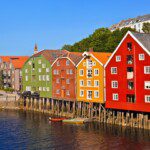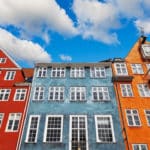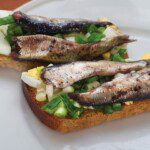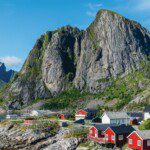Copenhagen to Northern Norway
From beautiful cities that seamlessly blend historic architecture and modern design to sprawling landscapes of pristine natural beauty, Scandinavia has a lot going for it. This 15-day journey through Sweden, Denmark and Norway begins in stylish Copenhagen, where the streets are made for cycling. Discover the neoclassical architecture and delicious hagabullen (cinnamon buns) of Gothenburg before escaping to the serene beaches and nature reserves of the Gothenburg archipelago. Have your curiosity piqued at Oslo’s eccentric museums and discover endless photo opportunities in Trondheim, one of Norway’s prettiest towns. Explore the majestic mountains, deep fjords and untamed beauty of Norway’s north while exploring around the Lofoten Islands. Wrap up the adventure above the Arctic Circle in Tromso, under the midnight sun.
15 days, from
$7,360
per person
GROUP SIZE
ACTIVITY LEVEL
Details
Countries Visited:
Denmark
Norway
Sweden
Accommodation: Hotel (10 nights), Pension (3 nights)
Transportation: Train , Public bus , Plane , Ferry , Private vehicle , Boat , Bicycle , Tram , E-bike
Included Meals:
- 14 breakfasts
- 1 lunches
Group size: Minimum 1, Max 12
Minimum Age: 15
Explore Copenhagen like a local and hop on a bike. There is no better way to see the major sites, as well as explore hidden corners of this beautiful city.
Don't miss Gothenburg's Haga district, with its picturesque wooden houses and the iconic Skansen Kronan, as well as laid-back Langgatan street.
Take a ferry to Vrango Island, a stunning fishing town in the Gothenburg Archipelago, and discover this rocky nature haven by kayak.
Visit Trondheim, which translates as 'a good place to live', stroll past the colourful wooden storehouses flanking the river, ride the northernmost tram and enjoy a forest walk and picnic just like the locals do.
Explore the long-adored Lofoten Islands, a patchwork of fishing villages, by land and sea and take in some of the most breathtaking scenery in the entire world.
Hop on an e-bike in Tromso, and learn about life hundreds of kilometres north of the Arctic Circle, where the arts and culture scene is thriving despite its isolated, northerly location.
Itinerary
Welcome to Copenhagen. If you arrive early, which is highly recommended, why not visit the pastel-coloured waterfront houses in the Nyhavn area. Drop in at an industrial-chic bar for a drink or stroll around the famous Tivoli Gardens, home to the world's oldest rollercoaster. Another area worth checking out is Norrebro, a residential area known for its wide range of restaurants. Meet your group at 6 pm then head out for an optional group dinner if it takes your fancy.
When in Copenhagen, do as the locals do and explore the city by bike, undoubtedly the best way to explore the city's many hidden corners. The bike-friendly streets mean cycling to the city's major sites are a breeze. Venture into the Freetown of Christiania with a local guide, a self-proclaimed autonomous neighbourhood south-east of the city centre. It is regulated by a special law, the Christiania Law of 1989, and has been a source of controversy since 1971 when squatters took over a former military area. The afternoon is free for you to further explore this Scandinavian city. Stroll along the harbour or head out to the classicist palaces of 18th century Amalienborg, to this day the main residence of the Danish Royal family. Perhaps pay a visit to Frederik's Church, also known as Marble Church, the Court House on Nytorv Square or check out the facade of the red brick town hall. Alternatively, the National Museum is not to be missed, nor is the Christiansborg Palace in the very centre of Copenhagen.
A morning train ride will get us to Malmo in Sweden, via the famous Oresund Bridge that spans the strait separating Denmark and the Scandinavian Peninsula (approx. 1 hour). Malmo has gone through somewhat of a transformation, or should we say revival, over the past twenty years thanks to the construction of the Oresund Bridge and the opening of Malmo University. Now, a city once reliant mainly on shipbuilding is growing steadily with architecture firms, IT companies, students and start-ups. Just under half of Malmo's population is under the age of 35, so it really now is a progressive city that knows how to have fun. Spend some time checking out the Old Town, the castle and the harbour, then continue on to Gothenburg (approximately 3 hours), where you'll spend the night.
Today is a free day for you to enjoy all that Gothenburg has to offer. Perhaps embark on a cruise this morning through Gothenburg's many waterways, passing the opera house, the famous fish market Feskekörka (literally Fish Church), and the old docks. Or visit the Göteborg City Museum, housed in the former East India Company House and built during the time when Gothenburg's role was that of a major maritime trading centre. Take in the architectural ensemble on Gustav Adolfs Torg, go shopping along the main boulevard Avenyn, check out the iconic Skansen Kronan, stroll along bohemian Långgatan street or sip a coffee in the charming Haga quarter, known for its picturesque wooden houses, 19th century atmosphere and the so-called hagabulle, a cinnamon pastry similar to kanelbulle.
Catch an early-ish ferry from Gothenburg to Vrango Island, approximately one hour and 20 minutes away. Vrango is the most southerly island of the Gothenburg Archipelago, with a permanent population in the low hundreds and a strong fishing industry. The island is known for its stunning beaches and protected nature reserves and you'll explore the coastline in an included kayaking activity (summer only). In the afternoon, enjoy some free time strolling around the town or maybe try an optional floating sauna, before returning to Gothenburg for a free evening. Sweden's second largest city is known as the world's most sustainable destination and is exemplary example of what a responsible tourism destination should look like.
Catch a morning bus across the border to Norway's capital Oslo (approx 4 hours). Your leader will take you on an initial orientation walk so you get a first taste of this quirky, colourful city. It's definitely worthwhile to spend the day perusing delicacies at Maschmanns Food Market, admiring the handiwork of glass blowers at the Hadeland Glassverk, or simply strolling along Karl Johans Gate, the main shopping strip of the city, or head to the National Gallery of Art to glimpse Edvard Munch's famous 19th century painting, The Scream. In the evening say 'skal' ('cheers') to the group over dinner. Why not seek out some traditional Norwegian fare based around cod and mackerel dishes.
Perhaps use your free day for island hopping on Oslofjord, putting the hammer down at the Viking Museum, tasting local flavours at the Mathallen food hall, exploring the immense Akershus Castle & Fortress, or checking out the cool shops in the Grunerløkka district. There's so much to get stuck in to.
Today you'll leave Oslo behind and take the train across the stunning countryside to Trondheim (approximately 7 hours). Trondheim was the first capital of Norway and remains the city where kings go through their coronation. Its name translates as 'a good place to live', with 'trond' meaning 'a good place' and 'heim' home, and it truly is. The city is situated on the Trondheimsfjord and colourful wooden storehouses flank the Nidelva River that runs through town, while the city's outskirts are surrounded by hilly wilderness. There are some great seafood restaurants in town, so why not venture out with the group for a bite to eat in the evening.
This morning, head out of Trondheim and hop on the 100-year-old northern-most tram to Bymarka Nature Reserve, during which you'll have an amazing view of the Trondheim city. Enjoy a walk following the forest trails, full of great view and even a glimpse of the Pilgrim Trail. Then enjoy a picnic lunch in the forest just like the Norwegians do. Back to Trondheim and then enjoy a free afternoon at your own pace. An absolute must see is the Nidaros Cathedral, an immense Gothic cathedral built from 1070 on, which remains the northernmost Gothic structure in Europe. Quite simply, it's incredible. Trondheim is a great city to explore on foot thanks to a bunch of lovely cafes and the Nordre Gate pedestrian-only area. There are several museums to visit including the Archbishop's Palace, which contains the real Crown Jewels, and the Rockheim Museum, providing a history of Norwegian pop music since the 1950s. Transfer in the evening to the station for an overnight train to Bodo, departing just before midnight.
Wake up just north of the Arctic Circle as we pull into the town of Bodø this morning. There's ample time for you to explore this interesting town until we leave on the afternoon ferry to Svolvaer on the Lofoten Islands. Bodø is a modern city as it was essentially destroyed by German bombers during WWII. With a dramatic backdrop of rugged ranges, Bodø has the densest population of white-tailed sea eagles in the world, so once you're done exploring why not grab a drink or some food by the quay and take in the vista while these impressive birds circle above (just watch your food). Board the afternoon ferry to the Lofoten Islands (approx 3.5 hours). Arrival will be at around 9 pm. Upon arrival settle into your comfortable accommodation in the town of Svolvaer.
The Lofoten Islands are known for picturesque fishing villages, pristine nature and, of course, the Midnight Sun. This is viking country, and the beauty of the area is unparalleled and near-impossible to convey in words. Svolvaer, one of the main towns on the islands, relies heavily on fishing and an ever-growing tourism industry as it's used as a primary base to explore the other islands. This morning head out on an excursion by RIB (rigid inflatable boat) to the narrow and steep-sided Trollfjord. On this exhilarating trip around the small islands and skerries of the Raftsundet Strait you'll also get the chance to see sea eagles. Sea eagles have the largest a wing span of any eagle, reaching up to 2.65 metres. It’s a special experience when one circles just a few metres above your head. The afternoon is free and there are several optional activities for you to choose from, so why not enjoy a sea kayaking trip around Svolvaer's picture-perfect harbour (subject to availability) or hike through the dramatic granite peaks jutting out of the ocean. Whatever you decide, you're guaranteed a pristine environment and scenery.
Depart the Lofoten Islands on a long but scenic travel day to Tromsø. Start with a local bus ride to Harstad (approx 3.5 hours). You'll have some free time here so perhaps take your time for lunch or explore the little town. Later on continue by local ferry past stunning scenery, plenty of fjords and even a maelstrom to Tromsø (approx 3 hours). Located far above the Arctic Circle, Tromsø is northern Norway's major cultural centre thanks to a range of music and arts festivals and an increasing student population courtesy of the University of Tromsø. Enjoy a free evening on arrival in town.
This morning, start exploring Tromsø on a e-bike tour and learn about the local life north of the Arctic Circle, stopping at some of local's favourite city sites like MS Polstjerna, an extremely well-preserved vessel that took part in seal hunting (entry not included), an old farmsted from the 19th century, Prestvannet, the biggest lake on the island and so on. Then explore Tromsø at your leisure. Learn about the region's fascinating history at the Polar Museum and Tromsø Museum, check out the many art galleries or perhaps take a boat cruise in the surrounding waters (the city is actually built on an island). No visit to Tromsø would be complete without a beer at the city's oldest pub, Olhallen, part of the Mack Brewery that is even older than the pub. It was founded by Ludwig Mack, a baker who cared not for the drunkenness of the townsfolk. Mack started brewing beer in 1877 as a less alcoholic alternative to the spirits drunk by most, and the brewery is still family owned and frequented by young and old, traveller and local, student and teacher. Perhaps meet in the evening for an optional final group dinner together.
Your trip comes to an end today. There are no activities planned for the final day and you are able to depart the accommodation at any time. If you want to extend your stay in Tromsø we are happy to book additional accommodation for you, subject to availability. Please enquire at the time of booking.







